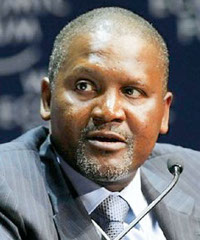Cement wars heat up in East Africa as Dangote plans entry
Competition is heating up in Kenya’s cement market as new players enter the market and existing companies expand their operations amidst growing consumption fuelled by a construction boom.
Kenya’s cement per capita consumption will for the first time surpass 100kgs per person in 2014 according to last year’s CW Group Kenya market update report.
Listed cement manufacturer East African Portland Cement Company is conducting feasibility studies in some parts of Kenya with a view of setting up a plant by 2016 that will manufacture clinker, which is used in making cement.
Another listed manufacturer, ARM Cement, is seeking US$300m to finance a project in Kitui town – about 180km east of Nairobi – which will produce 8,000 tons of cement per day making it the single largest cement factory in the country. ARM is hoping to double its annual production capacity to 5m tons in six years.
Recent entrants such as National Cement, Mombasa Cement and Savannah Cement are also pumping millions of dollars into new projects. Savannah Cement, a consortium of Chinese and Kenyan investors, has set up a $114.3m plant with capacity of 1.5m tons a year and is planning to invest another $172m in a clinker plant in the second phase of the project.
Cemtech Kenya, a subsidiary of Sanghi Group of India, is also putting up a $137.2m cement factory in Kenya.
The 2013 CW Group report predicted that these combined efforts will increase Kenya’s annual cement capacity to over 11.1m tons by the end of 2017. As at the end of 2012, Kenya’s cement production was 4.63m tons, according to the Kenya National Bureau of Statistics.
Kenya’s growing cement consumption is fuelled by an upsurge in private sector funded housing developments, foreign funded commercial projects and mega infrastructure projects ranging from ports, rail and roads financed by government and donors.
Pradeep Paunrana, managing director of ARM Cement, is optimistic that even with more production and competition, demand for cement in Kenya and East Africa will only increase.
“In Kenya and East Africa generally, our cement consumption per capita has been very low. As our economies are improving, as our aspirations of development are changing with more educated young people, we want more housing, more roads, more infrastructure… all these ultimately require a lot more cement.”
Dangote’s entry
This potential seems to have captured the attention of Africa’s richest man. Aliko Dangote is planning to build a $400m plant in Kenya that will have a daily capacity of about 5,500 tons.
Analysts have warned that the entry of Dangote Cement is likely to shake up the market.
“Going by Dangote Cement’s financial muscle and aggressiveness, an unprecedented battle could be in the offing,” said investment analysts at Old Mutual Securities in a research report last year.
Paunrana says ARM cement is not “concerned” about the entry of Dangote Cement and other players in the market.
“Aliko Dangote is a man to be admired. He has got an extremely successful cement business in Nigeria and in several other countries already. We are aware of his intentions and ambitions for starting a cement business in Kenya. Like all other [companies] Dangote Cement will also have to compete in the market.”


